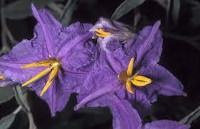Phytochemical Studies and Evaluation of Silver Nanoparticles Synthesized from <i>Solanum elaeagnifolium</i> Leaves Extract for Antioxidant and Antibacterial Activities
DOI:
https://doi.org/10.26538/tjnpr/v8i2.36Keywords:
Solanum elaeagnifolium, Green Synthesis, Antioxidant, AntibacterialAbstract
Solanum elaeagnifolium is a medicinal plant in the Solanaceae family and the leaves extract have traditionally been used to treat several diseases, including skin infections, respiratory problems, and digestive disorders. The purpose of the study was to formulate silver nanoparticles (AgNPs) from the leaves extract of Solanum elaeagnifolium using the green synthesis method and to evaluate the formulated nanoparticles using scanning electron microscope (SEM) and X-ray diffraction (XRD). The powdered leaves were analyzed for macroscopic, microscopic, and physicochemical characteristics before being extracted using a Soxhlet apparatus. The antioxidant effect was analyzed using 2,2-diphenyl-1-picryl hydrazyl (DPPH). The disk diffusion method was used for assessing the antibacterial activity. Microscopic examinations confirmed the existence of stellate trichomes. Phytochemical screening, confirmed the presence of flavonoids, alkaloids, tannins, saponins, triterpenoids, steroids, and cardiac glycosides. SEM revealed a porous, spherical and crystalline structure with particle sizes of 70-95 nm. The DPPH assay revealed IC50 values of 3.40, 2.30 and 1.40 mg/mL for the methanolic extract, silver nanoparticles and ascorbic acid respectively. The results of the antioxidant studies revealed that the formulated silver nanoparticles had higher antioxidant activity than the leaves extract at all concentrations. The leaves extract and silver nanoparticles demonstrated significant antibacterial activity against all the bacteria used in the study with zones of inhibition ranging from 2.9-4.8 mm and 5.7-9.2 mm respectively. The formulated silver nanoparticles demonstrated significant antibacterial and antioxidant effects as a result of the presence of some secondary metabolites such as phenols, saponins, flavonoids and tannins in the leaves extract.
References
Airemwen CO, Halilu ME. Formulation and in vitro evaluation of polymeric metronidazole nanoparticles. Pak. J. Pharm. Sci. 2022; 35(5):1333-1338.
Achmad S, Salmiati M, Mohd RS, Ahmad BK, Tony H, Hadi N. A Review of Silver Nanoparticles: Research Trends, Global Consumption, Synthesis, Properties, and Future Challenges. J. Chinese Chem. Soc. 2017; 5(1):1-26.
Hossain MR, Biplob AI, Sharif SR, Bhuiya AM, Sayem ASM. Antibacterial Activity of Green Synthesized Silver Nanoparticles of Lablab Purpureus Flowers Extract against Human Pathogenic Bacteria. Trop. J. Nat. Prod. Res. 2023; 7(8):3647-3651.
Thombre R, Parekh F, Lekshminarayanan P, Francis G. Studies on antibacterial and antifungal activity of silver nanoparticles synthesized using Artocarpus heterophyllus leaf extract. Biotechnol Bioinf Bioeng. 2012; 2:632–637.
Airemwen CO, Obarisiagbon AJ. Formulation of silver nanoparticles from the leaves extract of Vernonia amygdalina. The Nig J. Pharm. 2023; 57(1):459-466.
Tran TH, Nguyen TD, Nguyen HT, Le QH. Green synthesis of highly concentrated silver nanoparticles for applications in surface-enhanced Raman scattering spectroscopy J. Nano. Res. 2013;15(10): 19-27.
Yang X, Liu J, He W, Zhao Q, Tang Z, Zhang Y. Green synthesis of silver nanoparticles using grape seed extract and its application for electrochemical sensing of p-nitrophenol, RSC Adv. 2015; 5(46):36984–36991.
Omar MO, Ibrahim RM, Mohamed AK. Phytochemical and pharmacological properties of Solanum elaeagnifolium: A review. Arabian J. Chem. 2017; 6(10): S3070–S3079.
Rajalakshmi P, Pugalenthi M. Phytochemical screening and in vitro Antioxidant Activity of Lantana Camara L. and Solanum elaeagnifolium C. Int. J. Bot. Stud. 2016; 1:26–29.
Uludag A, Gbehounou G, Kashefi J, Bouhache M, Bon MC, Bell C, Lagopodi AL. Review of the current situation for Solanum elaeagnifolium in the Mediterranean Basin, Bulletin OEPP/EPPO Bull. 2016; 46(1):139–147.
Goyal S, Gupta N, Chatterjee S. Solanum elaeagnifolium: A review on its phytochemistry, pharmacology, and toxicology. J. Ethnopharm. 2021; 279:114300.
Abubakar AR, Haque M. Preparation of medicinal plants: Basic extraction and fractionation procedures for experimental purposes. J. Pharm. and Bioallied Sci. 2020; 12(1), 1-15.
WHO. Quality control methods for medicinal plant materials. World Health Organization, Geneva. 2011; pp. 5-43
Halilu ME, Abah JO, Almustapha NL, Achor M (2010). Phytochemical screening and mineral element analysis of the root bark of Parinari macrophylla Sabine (Chrysobalanaceae) and its effect on microorganisms. Con. J. Bio. Sci. 3; 46-50.
Ghasemzadeh A, Jaafar HZ, Rahmat A. Antioxidant activities, total phenolics and flavonoids content in two varieties of Malaysia young ginger (Zingiber officinale Roscoe). Mol. 2010; 15(6):4324-4333.
Halilu EM, Ngweh VA, Airemwen CO. Green Synthesis of Silver Nanoparticles from Parinari curatellifolia Methanol Stem Bark Extract and Evaluation of Antioxidant and Antimicrobial Activities. Trop. J. Nat. Prod. Res. 2023; 7(3): 2498-2505.
Nzekekwu AK, Abosede OO. Green Synthesis and Characterization of Silver Nanoparticles Using Leaves Extracts of Neem (Azadirachta indica) and Bitter Leaf (Vernonia amygdalina), J App. Sci. and Env. Man. 2019; 23 (4):695-699.
Arya G, Sharma N, Ahmed J, Gupta N, Kumar A, Chandra R, Nimesha S. Degradation of anthropogenic pollutant and organic dyes by biosynthesized silver nano-catalyst from Cicer arietinum leaves. J. Photochem. and Photobio. 2017; 174: 90-96.
Prasad TN, Elumalai EK. Biofabrication of silver nanoparticles using Moringa oleifera leaf extract and their antimicrobial activity. Asian Pac. J. Trop. Biomed. 2011; 1(6): 439–442.
Thangavelu SM. Medicinal plants mediated the green synthesis of silver nanoparticles and their biomedical applications (Review). IET Nanobiotechnol. 2022; 6(4): 115–144.
Kero J, Sandeep BV, Sudhakar P. Synthesis, Characterization, and Evaluation of the Antibacterial Activity of Allophylus serratus Leaf and Leaf Derived Callus Extracts Mediated Silver Nanoparticles. J. Nanomat. 2017; 6(5):114-122.
Khan I, Saeed K, Khan I. Nanoparticles: Properties, applications and toxicities. Arab. J Chem. 2018; 12(7): 908-931.
Lakshman KD, Siva SS, Sumaya ZS, Maneesha RK, Gayathri K, Godlaveeti SK, Lekshmi G. Phytochemical mediated synthesis of silver nanoparticles and their antibacterial activity. Appl. Sci. 2021; 3:631-640.
Omeche NB, Ezeala IC, Ikem CJ, Uzor PF. Green Synthesis of Silver Nanoparticles using Cola nitida Nut Extract (Vent.) Schott and Endl. (Malvaceae), Characterization and the Determination of their Antimicrobial Activity. Trop. J. Nat. Prod. Res. 2022; 6(1):156-160.
Haajira BHR, Ranjithkumar D, Santhoshini N, Velmurugan P, Ragul P, Ramalakshmi SS. Medicinal plants mediated the green synthesis of silver nanoparticles and their biomedical applications. IET Nanobiotechnol. 2022; 16(4): 115–144.

Published
How to Cite
Issue
Section
License
Copyright (c) 2024 Tropical Journal of Natural Product Research (TJNPR)

This work is licensed under a Creative Commons Attribution-NonCommercial-NoDerivatives 4.0 International License.


















